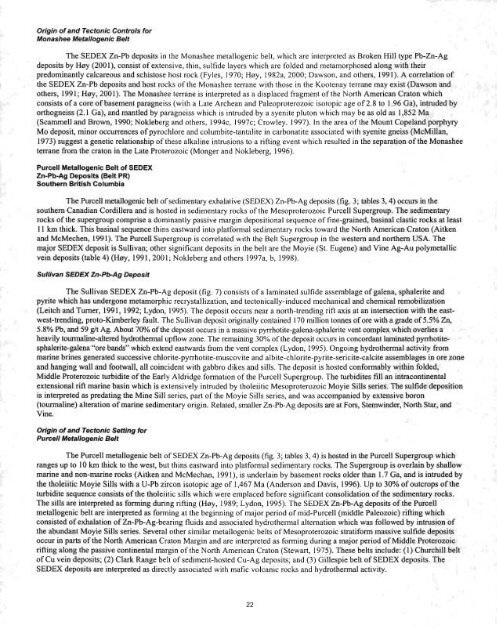Metallogenesis and Tectonics of the Russian Far East, Alaska, and ...
Metallogenesis and Tectonics of the Russian Far East, Alaska, and ...
Metallogenesis and Tectonics of the Russian Far East, Alaska, and ...
Create successful ePaper yourself
Turn your PDF publications into a flip-book with our unique Google optimized e-Paper software.
Origin <strong>of</strong> <strong>and</strong> Tectonic Controls for<br />
Monashee Metallogenic Belt<br />
The SEDEX Zn-Pb deposits in <strong>the</strong> Monashee metallogenic belt, which are interpreted as Broken Hill type Pb-Zn-Ag<br />
deposits by Hay (2001), consist <strong>of</strong> extensive, thin, sulfide layers which are folded <strong>and</strong> metamorphosed along with <strong>the</strong>ir<br />
predominantly calcareous <strong>and</strong> schistose host rock (Fyles, 1970; Hsy, 1982a, 2000; Dawson, <strong>and</strong> o<strong>the</strong>rs, 1991). A correlation <strong>of</strong><br />
<strong>the</strong> SEDEX Zn-Pb deposits <strong>and</strong> host rocks <strong>of</strong> <strong>the</strong> Monashee terrane with those in <strong>the</strong> Kootenay terrane may exist (Dawson <strong>and</strong><br />
o<strong>the</strong>rs, 1991; Hsy, 2001). The Monashee terrane is interpreted as a displaced fragment <strong>of</strong> <strong>the</strong> North American Craton which<br />
consists <strong>of</strong> a core <strong>of</strong> basement paragneiss (with a Late Archean <strong>and</strong> Paleoproterozoic isotopic age <strong>of</strong> 2.8 to 1.96 Ga), intruded by<br />
orthogneiss (2.1 Ga), <strong>and</strong> mantled by paragneiss which is intruded by a syenite pluton which may be as old as 1,852 Ma<br />
(Scammell <strong>and</strong> Brown, 1990; Nokleberg <strong>and</strong> o<strong>the</strong>rs, 1994c, 1997c; Crowley, 1997). In <strong>the</strong> area <strong>of</strong> <strong>the</strong> Mount Copel<strong>and</strong> porphyry<br />
Mo deposit, minor occurrences <strong>of</strong> pyrochlore <strong>and</strong> columbite-tantalite in carbonatite associated with syenite gneiss (McMillan,<br />
1973) suggest a genetic relationship <strong>of</strong> <strong>the</strong>se alkaline intrusions to a rifting event which resulted in <strong>the</strong> separation <strong>of</strong> <strong>the</strong> Monashee<br />
terrane from <strong>the</strong> craton in <strong>the</strong> Late Proterozoic (Monger <strong>and</strong> Nokleberg, 1996).<br />
Purcell Metallogenic Belt <strong>of</strong> SEDEX<br />
Zn-Pb-Ag Deposits (Belt PR)<br />
Sou<strong>the</strong>rn British Columbia<br />
The Purcell metallogenic belt <strong>of</strong> sedimentary exhalative (SEDEX) Zn-Pb-Ag deposits (fig. 3; tables 3,4) occurs in <strong>the</strong><br />
sou<strong>the</strong>rn Canadian Cordillera <strong>and</strong> is hosted in sedimentary rocks <strong>of</strong> <strong>the</strong> Mesoproterozoic Purcell Supergroup. The sedimentary<br />
rocks <strong>of</strong> <strong>the</strong> supergroup comprise a dominantly passive margin depositional sequence <strong>of</strong> fine-grained, basinal clastic rocks at least<br />
11 km thick. This basinal sequence thins eastward into platformal sedimentary rocks toward <strong>the</strong> North American Craton (Aitken<br />
<strong>and</strong> McMechen, 1991). The Purcell Supergroup is correlated with <strong>the</strong> Belt Supergroup in <strong>the</strong> western <strong>and</strong> nor<strong>the</strong>rn USA. The<br />
major SEDEX deposit is Sullivan; o<strong>the</strong>r significant deposits in <strong>the</strong> belt are <strong>the</strong> Moyie (St. Eugene) <strong>and</strong> Vine Ag-Au polymetallic<br />
vein deposits (table 4) (Hsy, 199 1, 2001 ; Nokleberg <strong>and</strong> o<strong>the</strong>rs 1997a, b, 1998).<br />
Sullivan SEDEX Zn-Pb-Ag Deposit<br />
The Sullivan SEDEX Zn-Pb-Ag deposit (fig. 7) consists <strong>of</strong> a laminated sulfide assemblage <strong>of</strong> galena, sphalerite <strong>and</strong><br />
pyrite which has undergone metamorphic recrystallization, <strong>and</strong> tectonically-induced mechanical <strong>and</strong> chemical remobilization<br />
(Leitch <strong>and</strong> Turner, 1991, 1992; Lydon, 1995). The deposit occurs near a north-trending rift axis at an intersection with <strong>the</strong> east-<br />
west-trending, proto-Kimberley fault. The Sullivan deposit originally contained 170 million tomes <strong>of</strong> ore with a grade <strong>of</strong> 5.5% Zn,<br />
5.8% Pb, <strong>and</strong> 59 glt Ag. About 70% <strong>of</strong> <strong>the</strong> deposit occurs in a massive pyrrhotite-galena-sphalerite vent complex which overlies a<br />
heavily tourmaline-altered hydro<strong>the</strong>rmal upflow zone. The remaining 30% <strong>of</strong> <strong>the</strong> deposit occurs in concordant laminated pyrrhotite-<br />
sphalerite-galena "ore b<strong>and</strong>s" which extend eastwards fiom <strong>the</strong> vent complex (Lydon, 1995). Ongoing hydro<strong>the</strong>rmal activity from<br />
marine brines generated successive chlorite-pyrrhotite-muscovite <strong>and</strong> albite-chlorite-pyrite-sericite-calcite assemblages in ore zone<br />
<strong>and</strong> hanging wall <strong>and</strong> footwall, all coincident with gabbro dikes <strong>and</strong> sills. The deposit is hosted conformably within folded,<br />
Middle Proterozoic turbidite <strong>of</strong> <strong>the</strong> Early Aldridge formation <strong>of</strong> <strong>the</strong> Purcell Supergroup. The turbidites fill an intracontinental<br />
extensional rift marine basin which is extensively intruded by tholeiitic Mesoproterozoic Moyie Sills series. The sulfide deposition<br />
is interpreted as predating <strong>the</strong> Mine Sill series, part <strong>of</strong> <strong>the</strong> Moyie Sills series, <strong>and</strong> was accompanied by extensive boron<br />
(tourmaline) alteration <strong>of</strong> marine sedimentary origin. Related, smaller Zn-Pb-Ag deposits are at Fors, Stemwinder, North Star, <strong>and</strong><br />
Vine.<br />
Origin <strong>of</strong> <strong>and</strong> Tectonic Setting for<br />
Purcell Metallogenic Belt<br />
The Purcell metallogenic belt <strong>of</strong> SEDEX Zn-Pb-Ag deposits (fig. 3; tables 3,4) is hosted in <strong>the</strong> Purcell Supergroup which<br />
ranges up to 10 km thick to <strong>the</strong> west, but thins eastward into platformal sedimentary rocks. The Supergroup is overlain by shallow<br />
marine <strong>and</strong> non-marine rocks (Aitken <strong>and</strong> McMechan, 1991), is underlain by basement rocks older than 1.7 Ga, <strong>and</strong> is intruded by<br />
<strong>the</strong> tholeiitic Moyie Sills with a U-Pb zircon isotopic age <strong>of</strong> 1,467 Ma (Anderson <strong>and</strong> Davis, 1996). Up to 30% <strong>of</strong> outcrops <strong>of</strong> <strong>the</strong><br />
turbidite sequence consists <strong>of</strong> <strong>the</strong> tholeiltic sills which were emplaced before significant consolidation <strong>of</strong> <strong>the</strong> sedimentary rocks.<br />
The sills are interpreted as forming during rifting (Hsy, 1989; Lydon, 1995). The SEDEX Zn-Pb-Ag deposits <strong>of</strong> <strong>the</strong> Purcell<br />
metallogenic belt are interpreted as forming at <strong>the</strong> beginning <strong>of</strong> major period <strong>of</strong> mid-Purcell (middle Paleozoic) rifting which<br />
consisted <strong>of</strong> exhalation <strong>of</strong> Zn-Pb-Ag-bearing fluids <strong>and</strong> associated hydro<strong>the</strong>rmal alternation which was followed by intrusion <strong>of</strong><br />
<strong>the</strong> abundant Moyie Sills series. Several o<strong>the</strong>r similar metallogenic belts <strong>of</strong> Mesoproterozoic stratiform massive sulfide deposits<br />
occur in parts <strong>of</strong> <strong>the</strong> North American Craton Margin <strong>and</strong> are Interpreted as forming during a major period <strong>of</strong> Middle Proterozoic<br />
rifting along <strong>the</strong> passive continental margin <strong>of</strong> <strong>the</strong> North American Craton (Stewart, 1975). These belts include: (1) Churchill belt<br />
<strong>of</strong> Cu vein deposits; (2) Clark Range belt <strong>of</strong> sediment-hosted Cu-Ag deposits; <strong>and</strong> (3) Gillespie belt <strong>of</strong> SEDEX deposits. The<br />
SEDEX deposits are interpreted as directly associated with mafic volcanic rocks <strong>and</strong> hydro<strong>the</strong>rmal activity.
















